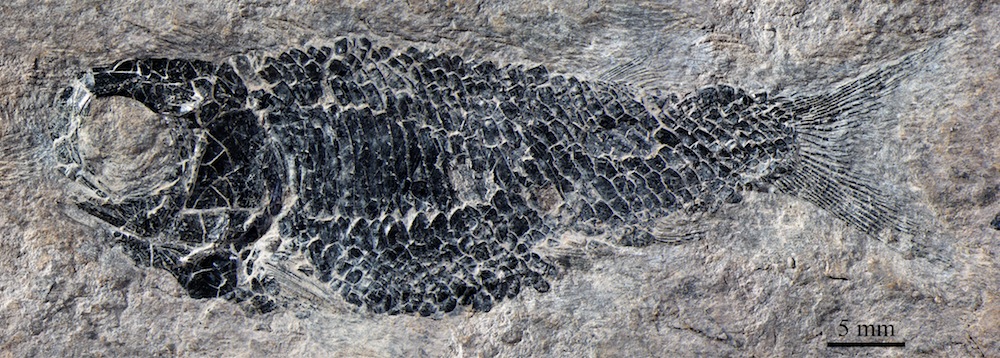How Flying Fish Took Flight? Fossils May Tell Us

An extinct flying fish may shed light on how gliding evolved in such animals, researchers say.
Modern flying fish are famous for leaping from the water to glide in the air using long, winglike fins, presumably to escape aquatic predators. Much remains unknown about how modern flying fish developed their gliding abilities, since there is little in the way of missing-link fossils to illuminate how these fish evolved flight.
However, modern flying fish, known as exocoetids, were not the only fish to evolve gliding. Extinct flying fish known as thoracopterids evolved bodies remarkably similar to exocoetids more than 200 million years ago, during the Triassic period. [Photos: The Freakiest-Looking Fish]
Now, a newfound thoracopterid species is casting light on how these extinct flying fish developed the ability to glide, and could yield insights into how modern flying fish evolved flight as well.
The new fish is named Wushaichthys exquisitus, which means "exquisite fish from Wusha" in Greek and Latin. (Wusha is the town in the southern Chinese province of Guizhou where the fossils were found.)
The scientists discovered six well-preserved specimens of Wushaichthys in 2010. The fossils are 235 million to 242 million years old, back when the area they dwelled in was part of the hot uppermost waters of the ancient Palaeotethys Ocean. During this period, Wushaichthys lived alongside shrimp, fish, mollusks and marine reptiles such as dolphin-shaped ichthyosaurs.
The extinct fish was relatively small, measuring up to about 2 inches (5.2 centimeters) long. The researchers suggest it may have eaten plankton, and been prey for marine reptiles and larger carnivorous fishes.
Get the world’s most fascinating discoveries delivered straight to your inbox.
"When the fish fossils were collected in the fieldwork, we had no idea what kind of fish this was," said lead study author Guang-Hui Xu, a vertebrate paleontologist at China's Institute of Vertebrate Paleontology and Paleoanthropology in Beijing. "After painstaking specimen preparation in the lab by myself, taking about three months, I recognized that it was, unexpectedly, related to the ancestor of the thoracopterid flying fishes."
Wushaichthys is the oldest and most primitive thoracopterid discovered yet. The roof of its skull was broad, as is seen in later thoracopterids, which probably evolved to help it live and feed in the ocean's uppermost waters.
This newfound fish was probably not a glider. It lacked the bottom-heavy tail fin seen in all known subsequent thoracopterids that helped them generate the power needed to launch them out of the water. Wushaichthys also lacked the winglike fins seen in later thoracopterids that would have helped them glide. Moreover, Wushaichthys was fully covered in scales, unlike more advanced thoracopterids that lost their body scales, which presumably helped improve their gliding efficiency and maneuverability.
"Resembling modern flying fish, thoracopterid flying fishes most probably used gliding as an escape strategy from predators," Xu told Live Science.
These new findings yield major insights on the evolution of flight in thoracopterids. Based on Wushaichthys and other thoracopterid fossils, Xu and his colleagues suggest the development of gliding in these fish was a gradual, four-step process. First, they evolved skulls that helped them live in surface waters. Next, they evolved tails that helped launch them from the water. Then, they evolved winglike fins that helped them glide. Finally, they lost body scales to make them more aerodynamic.
Xu suggests these findings could help explain the evolution of flight in modern flying fishes as well, due to similarities in body shape between the extinct thoracopterids and living exocoetids.
"Overwater gliding adaptations were gradual in nature," Xu said.
However, these findings show at least one major difference between thoracopterids and exocoetids. Although modern flying fish are all egg-layers, male Wushaichthys possessed hooklets on the anal fin resembling those seen on modern viviparous, or live-bearing, fish, which suggests thoracopterids gave birth to live offspring just like humans and whales do.
"These hooklets played an important role in sperm transfer to females," Xu said. "A study of the living viviparous guppy showed that up to threefold more sperm were transferred when males had hooklets compared with those with hooklets removed."
Xu and his colleagues Li-Jun Zhao and Chen-Chen Shen detailed their findings online today (Jan. 7) in the journal Biology Letters.
Follow Live Science @livescience, Facebook & Google+. Originally published on Live Science.




